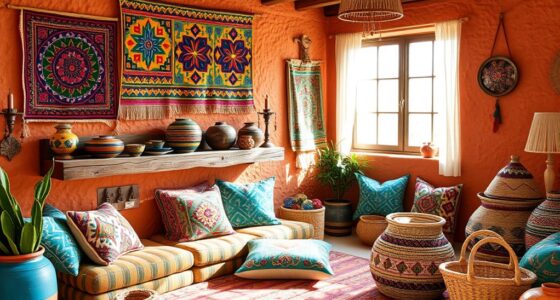Maori art influences textiles through traditional techniques like tukutuku, whiri, and tapa, featuring symbolic motifs such as tā moko and koru that represent identity, genealogy, and spiritual meaning. Contemporary artists blend these motifs with modern methods, creating innovative designs for fashion and interior decor that honor cultural heritage. As Maori textiles gain global recognition, they foster cultural exchange and inspire new artistic expressions, showing how tradition and innovation work together—if you explore further, you’ll discover the rich stories behind these vibrant patterns.
Key Takeaways
- Maori art influences textiles through traditional motifs like tā moko, koru, and whāriki woven patterns, symbolizing identity and cultural stories.
- Contemporary artists blend Maori motifs with modern embroidery and mixed media for innovative textile designs.
- Maori-inspired patterns are incorporated into fashion, interior decor, and accessories, reflecting cultural heritage globally.
- Traditional techniques such as tukutuku, tapa cloth, and muka fibers are preserved and adapted in modern textile practices.
- The global recognition of Maori textiles fosters cultural exchange, appreciation, and support for Maori artisans and heritage.
Traditional Maori Weaving Techniques and Their Modern Applications
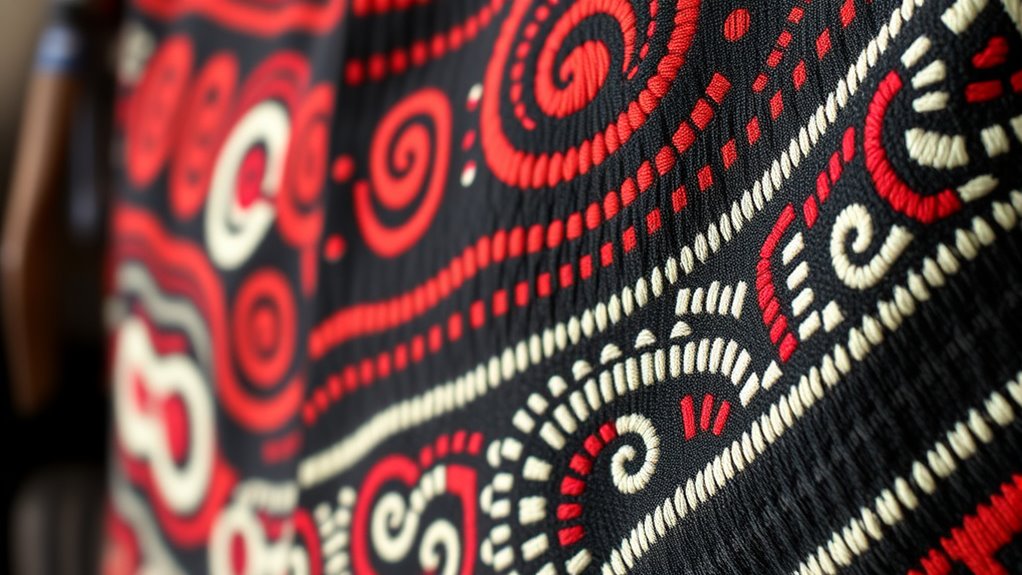
Traditional Maori weaving techniques, such as tukutuku and whiri, have been passed down through generations, preserving intricate patterns and methods. One key aspect is tapa cloth, made from beaten bark, which highlights the Maori’s skill in creating durable, decorative textiles. Another essential material is muka fibers, derived from the inner bark of the New Zealand flax plant, used to produce fine, strong threads for weaving. These techniques have modern applications, where artisans incorporate tapa cloth designs and muka fibers into contemporary fashion and art pieces. By blending traditional methods with new materials, Maori weavers continue to honor their heritage while innovating in textile design. Additionally, the use of sustainable and renewable materials such as flax fibers underscores their commitment to environmentally friendly practices. Your understanding of these techniques reveals the depth of Maori craftsmanship and its ongoing influence today.
Symbolism and Patterns in Maori Fabric Design
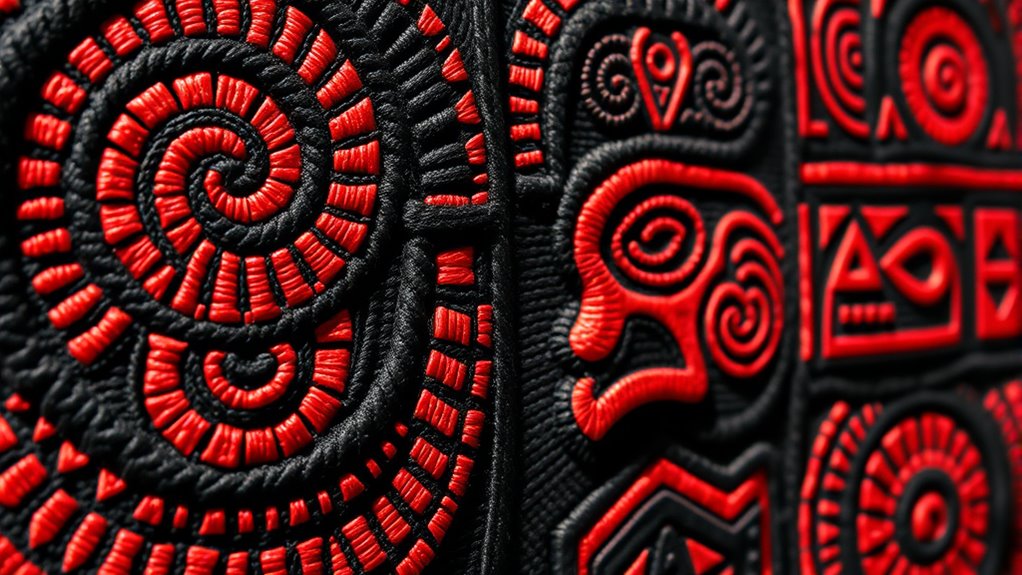
You notice how Maori fabric designs feature specific motifs with deep meanings. Each pattern reflects identity, history, or social status within the community. Understanding these symbols helps you appreciate the cultural significance woven into every piece. Additionally, these intricate designs are often created using traditional methods that have been passed down through generations, preserving their authenticity and cultural heritage.
Traditional Motifs and Meanings
Maori fabric designs are rich with symbolic motifs that convey stories, status, and spiritual beliefs. One prominent motif is tā moko, which you might recognize as traditional facial or body tattoos, representing identity, social rank, and achievements. This symbolism extends into textiles, where tā moko-inspired patterns honor ancestors and personal histories. Another key element is koru symbolism, inspired by the unfurling fern frond, representing new life, growth, and harmony with nature. These motifs are often woven or printed into fabrics to embed cultural meanings, serving as visual stories that connect you to Maori heritage. Additionally, understanding the symbolic significance of these motifs enriches appreciation for their cultural depth and spiritual importance. By understanding these motifs, you gain insight into the values and history embedded in traditional Maori textiles, keeping their spiritual and cultural significance alive today.
Pattern Symbolism and Identity
Patterns in Maori fabric design serve as powerful symbols of individual and collective identity, conveying stories, social status, and spiritual beliefs. Kākahu patterns often reflect a person’s whakapapa and achievements, with intricate motifs that identify tribe and rank. Tā moko, the traditional facial tattooing, influences these patterns, representing personal history and spiritual connections. When woven into textiles, these symbols communicate a wearer’s lineage and social standing without words. Each pattern carries specific meanings, from protection to mana, shaping how others perceive and respect the individual. By understanding these symbols, you gain insight into Maori culture and identity. The integration of tā moko-inspired motifs and distinct kākahu patterns keeps cultural heritage alive in textile art, reinforcing community bonds and ancestral ties. Additionally, the use of sustainable materials in fabric production reflects a respect for the natural environment, which is a core value in Māori tradition.
Contemporary Artists Merging Maori Motifs With Textile Art

Contemporary artists are increasingly blending traditional Maori motifs with innovative textile techniques, creating works that honor cultural heritage while pushing artistic boundaries. They utilize methods like digital embroidery to add intricate details and precision, blending modern technology with traditional designs. Mixed media approaches combine various materials, enriching textures and visual impact.
- Artists incorporate Maori symbols into digital embroidery, enhancing detail and accuracy.
- They experiment with mixed media, layering fabrics, beads, and digital prints to create dynamic pieces.
- Some merge traditional motifs with contemporary themes, making cultural art relevant today.
- These artists challenge norms by fusing Maori art with modern textile techniques, expanding its reach and influence.
This blending celebrates Maori heritage while exploring new artistic frontiers, engaging audiences in fresh, meaningful ways.
The Role of Maori Art in Fashion and Interior Decor
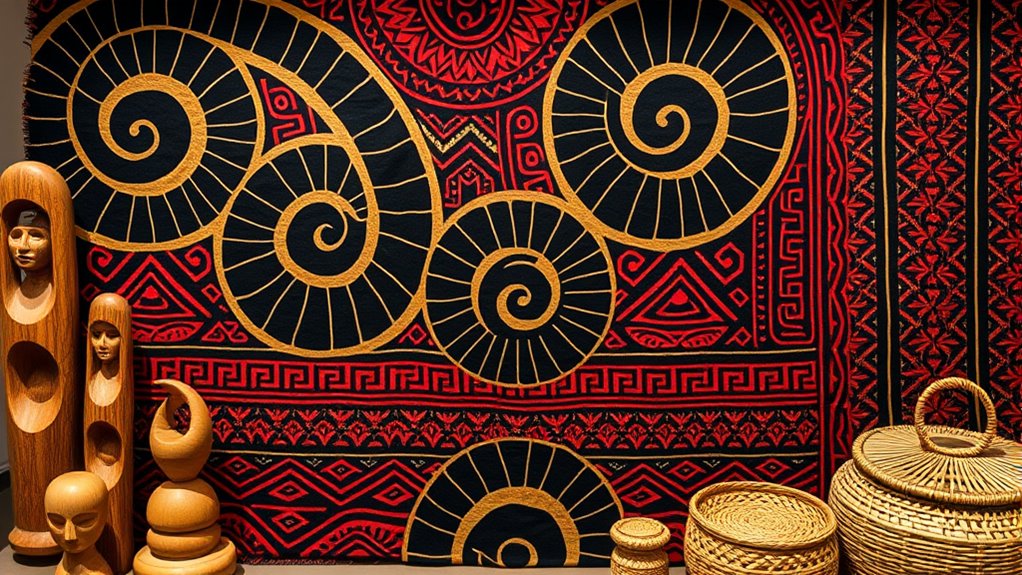
You’ll notice how traditional Maori motifs are becoming popular in modern fashion and interior decor, adding cultural depth to everyday spaces. Contemporary designers incorporate these patterns to create bold statements or subtle accents that honor Maori heritage. By integrating these elements, you actively participate in a rich cultural dialogue that shapes contemporary aesthetic choices. Additionally, understanding the significance of these motifs can deepen appreciation for their cultural symbolism and traditional craftsmanship.
Traditional Motifs in Design
Maori art’s traditional motifs play a vital role in shaping designs for fashion and interior decor, bringing a sense of cultural depth and storytelling to modern spaces. You’ll notice tā moko patterns often influence bold, intricate designs that symbolize identity and heritage. Similarly, whāriki patterns, with their geometric shapes and vibrant colors, add a layered richness to textiles. These motifs serve as visual narratives, connecting contemporary pieces to ancestral traditions. Incorporating these cultural symbols into textiles helps preserve heritage while inspiring innovative design. Both motifs are adapted into textiles for clothing, rugs, and wall hangings. Their use maintains cultural significance while enhancing aesthetic appeal.
Contemporary Maori-Inspired Fashion
Have you noticed how traditional Maori motifs are making a striking comeback in modern fashion and interior design? Designers draw inspiration from Maori tattooing, incorporating its bold lines and intricate patterns into contemporary clothing. Maori-inspired fashion often features motifs from ceremonial garments, blending tradition with modern aesthetics. You might see these designs on streetwear, accessories, or high-end runway pieces, creating a powerful connection to Maori culture. This trend honors the artistry and symbolism behind Maori tattooing, highlighting its significance beyond traditional contexts. By integrating ceremonial garment patterns into everyday fashion, creators celebrate Maori heritage while making it accessible and relevant today. It’s a vibrant way to keep Maori art alive, influencing how you express identity and cultural appreciation through style. Additionally, the use of authentic Maori art in textiles ensures that the cultural significance and craftsmanship are preserved and respected.
Interior Decor Elements
The influence of Maori art extends beyond fashion, making a bold statement in interior decor as well. You can incorporate Maori motifs to highlight your space’s textile heritage and cultural richness. Here are four ways to do this:
- Use woven Maori textiles as wall hangings or upholstery to add texture and cultural depth.
- Incorporate carved wooden accents inspired by traditional Maori symbols for a striking focal point.
- Choose cushions or throws featuring Maori patterns to bring vibrancy and storytelling into your room.
- Display Maori art prints or paintings that showcase intricate designs and symbolism. Practicing self-reflection can also help you understand how to authentically incorporate cultural elements into your decor.
Preservation and Innovation: Challenges Facing Maori Textile Heritage
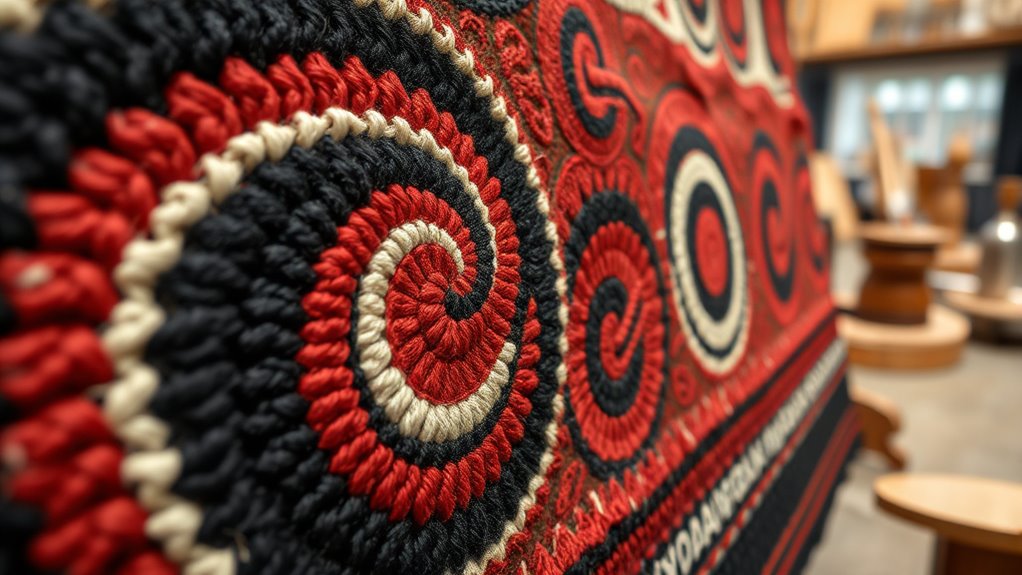
Preserving Maori textile heritage faces significant challenges as modern influences and environmental pressures threaten traditional techniques and materials. You must prioritize maintaining cultural authenticity, ensuring that authentic designs and methods are preserved without commercialization diluting their significance. Protecting intellectual property rights is essential to prevent unauthorized use or misappropriation of Maori symbols and motifs. As you navigate these challenges, you might find that younger generations are less engaged, risking the loss of skills and knowledge. Innovation offers opportunities to adapt, but it must respect the origins and cultural context of the textiles. Striking a balance between preserving tradition and embracing new ideas is vital to safeguarding Maori textile heritage for future generations, ensuring its authenticity remains intact. Incorporating diverse designs and colors can help keep the tradition relevant and engaging for contemporary audiences.
Global Influence and Cultural Appreciation of Maori-Inspired Textiles
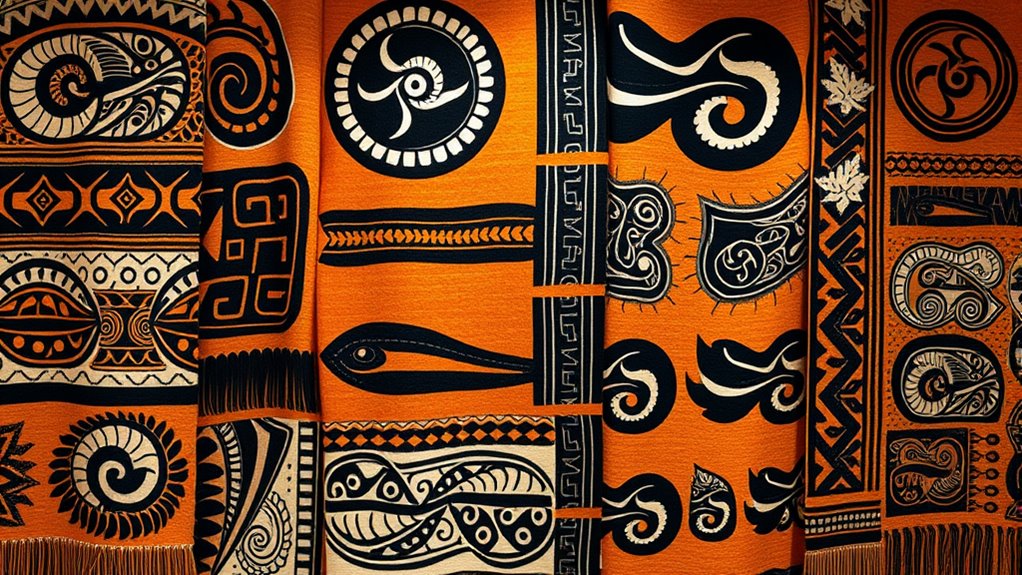
As Maori-inspired textiles gain global recognition, they serve as powerful symbols of cultural identity and artistic excellence. This surge fosters cultural exchange, allowing people worldwide to appreciate Maori traditions. You’ll notice how these textiles influence modern fashion and interior design, reflecting artistic globalization. Additionally, the use of traditional motifs in Self Watering Plant Pots demonstrates how cultural elements can be incorporated into everyday objects, blending functional design with cultural storytelling. 1. Artisans and designers incorporate Maori motifs, blending tradition with contemporary styles. 2. Cultural exchange promotes understanding and respect for Maori heritage. 3. Museums and exhibitions showcase these textiles, spreading awareness internationally. 4. The global appreciation encourages sustainable practices and supports Maori artisans. Through this influence, Maori textiles transcend borders, inspiring new creative expressions while honoring their deep cultural roots. You become part of a broader movement that values authentic cultural appreciation and artistic diversity.
Frequently Asked Questions
How Do Maori Textiles Reflect Their Cultural Beliefs and Societal Values?
You can see Maori textiles reflecting their cultural beliefs through symbolic meanings and spiritual significance woven into each piece. These textiles often depict ancestral stories, tribal identity, and social status, serving as visual language. By creating intricate patterns and designs, you honor spiritual connections and societal values, making each textile a meaningful expression of identity and tradition that preserves their heritage and reinforces community bonds.
What Are the Main Differences Between Traditional and Contemporary Maori Textile Methods?
Ever wondered how traditional and contemporary Maori textile methods differ? You’ll find that traditional weaving techniques often use natural fibers and hand-spun yarns, while contemporary methods might incorporate synthetic fibers and modern tools. Dyeing methods also vary; traditional textiles use natural dyes from plants, whereas modern textiles experiment with synthetic dyes for brighter, more varied colors. These differences showcase how Maori artisans adapt while honoring their cultural roots.
How Do Maori Motifs Influence Global Fashion Trends Today?
You see Maori motifs shaping global fashion trends through contemporary adaptations that blend traditional designs with modern styles. Designers incorporate these patterns into clothing, accessories, and textiles, creating unique, culturally rich pieces. You might notice collaborations between Maori artists and international brands, fostering cross-cultural appreciation. These global collaborations help spread Maori artistry worldwide, inspiring new fashion expressions that honor tradition while embracing innovation.
What Efforts Are Being Made to Teach Maori Weaving Techniques to Younger Generations?
You might be surprised to learn that efforts to teach Maori weaving techniques focus heavily on cultural preservation and engaging youth. Schools, community groups, and workshops actively pass down traditional skills like whiri and raranga. These initiatives aim to inspire younger generations to value their heritage, ensuring these intricate arts continue. By involving youth in hands-on learning, they foster pride and keep Maori weaving vibrant and alive for future generations.
How Can Non-Maori Artists Respectfully Incorporate Maori Patterns Into Their Work?
You should approach incorporating Maori patterns with cultural sensitivity, ensuring you respect their significance. Engage in open artistic collaboration with Maori artists to gain authentic insights and guidance. Always seek permission and credit the sources properly. By working respectfully and valuing their cultural heritage, you honor Maori traditions and create meaningful, culturally respectful art that celebrates their rich artistic legacy.
Conclusion
By embracing both tradition and innovation, Maori textiles continue to weave a vibrant tapestry that bridges past and present. Your appreciation fuels their preservation, allowing these intricate patterns to dance across modern fabrics like a song carried on the wind. As you explore Maori-inspired designs, remember you’re helping keep this cultural masterpiece alive—an enduring legacy that blooms with each new creation, painting the world with the rich hues of Maori artistry.






